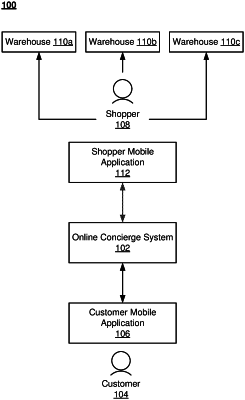| CPC G06Q 10/0833 (2013.01) [G06Q 10/087 (2013.01)] | 20 Claims |

|
1. A method comprising:
receiving an order at an online concierge system from a user, the order including one or more items and identifying a location to which the one or more items are delivered, the order to be displayed to one or more shopper mobile applications for one or more shoppers to select whether to fulfill the order;
determining, by a first machine learning model, a predicted delivery time for the order, the predicted delivery time determined from the location identified by the order and historical rates at which shoppers decide to select orders within a geographic region that includes the location, the predicted delivery time including a predicted length of time that a particular shopper decides to accept the order for fulfillment;
determining a modification to the predicted delivery time by applying a second machine learning model to the predicted delivery time, the second machine learning model determining the modification to optimize a predicted time identified to the user for fulfillment of the order subject to a constraint that a probability of the order being fulfilled after a time identified by the online concierge system does not exceed a threshold probability, wherein training of the second machine learning model comprises:
setting a threshold probability of the order being fulfilled after the predicted delivery time determined by the first machine learning model,
subjecting the modification to a constraint that a probability of the order being fulfilled after the predicted delivery time determined by the first machine learning model does not exceed the threshold probability, and
solving a stochastic optimization problem with the constraint that involves the predicted delivery time determined by the first machine learning model;
generating a modified delivery time by combining the predicted delivery time and the modification;
generating an estimated time of arrival of the order to the user by combining the modified delivery time and a time when the online concierge system received the order; and
displaying the estimated time of arrival to the user in an interface in conjunction with information identifying the order.
|